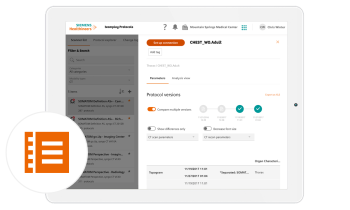Article • Innovations
Aiding radiologists to stride forward
Growth! New hardware, new software, richer imaging, enhanced communication and image transfer plus artificial intelligence (AI) are all pushing the pace that medical organisations, radiologists and device manufacturers must run to keep up. We spoke with Dr Erik Ranschaert, President of EuSOMII, about today’s changing face of radiology.
Report: Daniela Zimmermann

Alongside exceptional advances affecting radiologists, the European Society of Medical Imaging Informatics (EuSOMII) developed. Explaining the society’s current strong focus on AI, Dr Erik Ranschaert, an expert in IT, AI and a range of teleradiology applications, and President of EuSOMII, said: ‘What we are trying to do, is be a society not only for radiologists but also for clinical physicists and professionals of imaging informatics and other specialties and experts, so that we can join forces and communicate on how we can collaborate. ‘This is about sharing information on the one side and, on the other, informing radiologists and other specialties about changes. In an educative role, we want to give them a better view or insight into what is going on related to digitisation of our profession.’
There is no standardisation yet and this is one of the topics that needs to be discussed and addressed
Erik Ranschaert
EuSOMII is affiliated to the European Society of Radiology (ESR) and has links with other sub-speciality societies with experts available to collaborate with the ESR on production of publications and White Papers on subjects such as AI. Ranschaert is keen to point out that AI is rapidly becoming a very broad subject, for example moving beyond automated analysis of images and categorisation to detect whether a lesion is benign or malignant. This has evolved into segmentation: AI can automatically segment and differentiate areas of an organ; detection, such as identifying whether there is a tumour or not; and skeletal imagery to analyse bone type and size, for example to automatically calculate the age of a child. ‘All these are simple, narrow types of AI tasks, but another way we can use AI is to manage and detect the gaps in the workflow,’ Ranschaert added. ‘AI can automatically assign specific determinations to specific experts or radiologists, or also be used to reduce waiting lists. A very good example of this is in using electronic patient records. When a patient needs a CT scan, the scanner will be automatically programmed to choose the right scanning protocol depending on size, age, weight of patient and questions asked.’
That can be extended to managing radiation dose based on scanning protocols and the nature of the scan needed for a specific patient, a move he suggests will lead to fewer errors. However, there remains one critical area that has yet to be resolved, that of standardisation. ‘There is no standardisation yet and this is one of the topics that needs to be discussed and addressed,’ Ranschaert pointed out. Optimal interoperability between all e-systems involved in this process is primordial, facilitating the exchange of all necessary data.
Source: Shutterstock/LeoWolfert
Europe is ‘lagging behind’
The American College of Radiologists (ACR DSI) is actively considering this issue but, he said, there still needs to be a standardised way of software validation; a need to develop standards and guidelines about how to approve software, and monitor how or whether the software is getting better. The ACR DSI calls this the ‘AI Ecosystem', in which all stakeholders know which pathways they have to follow to develop and implement AI-based software. ‘We need to look at what the effect is on the disease outcome, for example, and how much it is influenced by certain software bias,’ Ranschaert said. ‘We do need to work on that. It is a very important topic.’
EuSoMII held its annual meeting in Rotterdam (3 November) with speakers from the USA and Europe, and hopes for a joint meeting in 2019 by establishing a partnership with the USA’s Society for Imaging Informatics in Medicine (SIIM). ‘We are trying to exchange information and collaborate and establish standards,’ he explained. As regards development of AI globally – not just in healthcare – he said the USA is a clear leader, followed by China and India, but Europe is ‘lagging behind’, though the UK is a leader in the field along with Germany, France and the Netherlands, with Israel also being quite active. However, he stressed that, Europe is a frontrunner in terms of protection and regulation of patient data when using AI, notably with the implementation of the GDPR (General Data Protection Regulation). On the other hand, this could also bear the risk of a conflict between the legal protection of health data for privacy reasons and the growing demand for such data to the benefit of improving healthcare services for the European population, which might be a substantial hurdle for the fast development of AI software in Europe.
EuSoMII is a young society working to expand from its current membership of around 200, and aiming to attract a younger generation of practitioners. ‘We think they should be involved in this evolution because it will be they who will have to embrace AI in the future,’ Ranschaert emphasised. Outreach, through the use of channels such as social media, is working to attract as many residents as possible by having a very low threshold for the society membership and a reduced price for younger radiologists. In an address to the annual meeting of the Belgian Society of Radiology (BSR), the younger section has organised a separate AI-meeting during which Ranschaert and several other experts in the field will speak to residents.
EuSOMII is also participating in an online programme organised by the RSNA and SIIM to teach residents about AI and imaging informatics. This National Imaging Informatics Course (NIIC) takes place from October 9-12. Ranschaert is also co-editor of a new book about AI and medical imaging informatics with a preliminary version to be published at the time of the RSNA congress in Chicago, which features a collection of chapters on different aspects of artificial intelligence.
11.11.2018










